3 - An illustrative case and first objections
Published online by Cambridge University Press: 08 January 2010
Summary
THE JUDICIAL STANDPOINT
Much of the preceding discussion is theoretical in that it concerns how we, as observers of the judicial process, might understand judging, albeit with regard for the judicial standpoint. Typical judges would voice little of it in their opinions or elsewhere. For the most part, judges go about their business on the basis of unarticulated intuitions about the nature of judging. There are no grounds for criticism in that. My goal is not to describe typical judicial beliefs in the American legal culture, which continues to bear the marks of determinate-formalism and legal skepticism in reaction. It is, rather, to elaborate an understanding of how judging in good faith is possible and might be desirable, at a higher level of abstraction and in greater detail than judges have occasion to articulate. A thoughtful and reflective judge should be able to recognize an ideal version of what he or she tries to do from my account, but it is no ground for criticizing the good faith thesis that judges do not explain what they do in similar terms.
It is time, however, to turn from the philosophical outsider's standpoint, take up the judicial standpoint more directly, and get down to cases. There are limits to how effectively any academic writer can do this. The experience of being a judge cannot be fully mimicked or imagined.
- Type
- Chapter
- Information
- Judging in Good Faith , pp. 69 - 104Publisher: Cambridge University PressPrint publication year: 1992



